Impacts of Industrial Animal Production on Rivers and Estuaries
By Michael A. Mallin
Animal-waste lagoons and sprayfields near aquatic environments may significantly degrade water quality and endanger health
Animal-waste lagoons and sprayfields near aquatic environments may significantly degrade water quality and endanger health

DOI: 10.1511/2000.15.26
On June 22, 1995, the citizens of Onslow County in North Carolina's Coastal Plain awoke to a remarkably unpleasant sight. During the previous evening a swine waste-holding lagoon had ruptured, sending approximately 25 million gallons (95 million liters) of concentrated feces and urine across a road and fields and into the New River, a coastal namesake of the far longer and older Appalachian river.
During the following day the putrefying mass traveled approximately 22 miles down the river, where it slowed just upstream of the city of Jacksonville. Over the next few days, some of this waste load would work its way down into the New River Estuary. There its effects on marine life would linger for three months.

For the previous year, my laboratory at the University of North Carolina at Wilmington had been studying the water quality of the New River Estuary in collaboration with JoAnn Burkholder's laboratory at North Carolina State University. After a hasty exchange of phone calls early on the 23rd, each lab sent a team to help investigate the effects of the enormous spill. My research assistant, Matt McIver, and I drove from Wilmington north to the town of Richlands, which has the sign "Welcome to Richlands-Town of Perfect Water" at the city limits. Finding a bridge under which the New River passed, we scrambled down the slope to find carcasses of fish representing numerous local species scattered along the bank and hanging in streamside bushes, the water turned murky brown with turbidity and a nauseating stench in the air. During the rest of the afternoon we checked various other accessible locations along the river, collecting water samples while state fish and wildlife workers picked up dead fish by the bucketload.
The seeming uniqueness of the event, combined with our available background data, made for an excellent opportunity to study the effects of a major waste-load spill on a river and its estuary. For the rest of the summer and early fall my laboratory conducted intensive physical, chemical and biological analyses of the estuary as Burkholder's NCSU lab contributed similar information for the river.
The event turned out not to be so unique after all. On July 3, 9 million gallons (34 million liters) of poultry waste poured from a breach in a lagoon in nearby Duplin County after heavy rains, polluting Limestone Creek and the Northeast Cape Fear River. On August 8, during dry weather, one million gallons (3.8 million liters) of swine waste leaked from a lagoon into Harris Creek in Brunswick County, and from there spread into a series of freshwater tidal creeks draining into the Cape Fear Estuary.
Several other well-publicized swine waste-lagoon spills also took place that summer in the Cape Fear and Neuse river basins. The following year Hurricane Fran swept through eastern North Carolina, followed by Hurricane Bonnie in 1998 and, as this article was in preparation, the most devastating flooding the region has seen, the triple punch from Hurricanes Dennis, Floyd and Irene in September and October 1999. Each hurricane season dumped large quantities of rain in floodplains dominated by industrial poultry and livestock operations, causing waste-holding lagoons to rupture or overflow and washing waste from sprayfields into rivers and estuaries simultaneously contaminated with overflows of domestic and industrial sewage. The resilience of a large and productive river and estuarine system has been sorely tested.
Many Americans have grown up on storybook images of the family farm, complete with chicken coop and pigs wallowing outdoors in a pen. Traditional mixed farming still predominates in developing countries; however, in the U.S. and elsewhere in the developed world, a typical poultry or swine operation bears scant resemblance to Old MacDonald's farm. In recent years the number of individual swine farmers has dropped dramatically, while the numbers of swine owned by a few producers has greatly increased. This trend appears to have been responsible for reducing production costs and raising productivity in the industry. In the current model hog-production operation, hundreds to thousands of animals are fed and raised wholly indoors in large, rectangular hog houses. The feces and urine generated by the animals are washed through slats in the building floor into a series of trenches and pipes beneath the structure that carry the waste outdoors into a large holding pit known as a waste lagoon. When the waste in the lagoon reaches a certain height, some of it is pumped out and sprayed onto surrounding fields that are often planted with a cover crop such as bermudagrass.
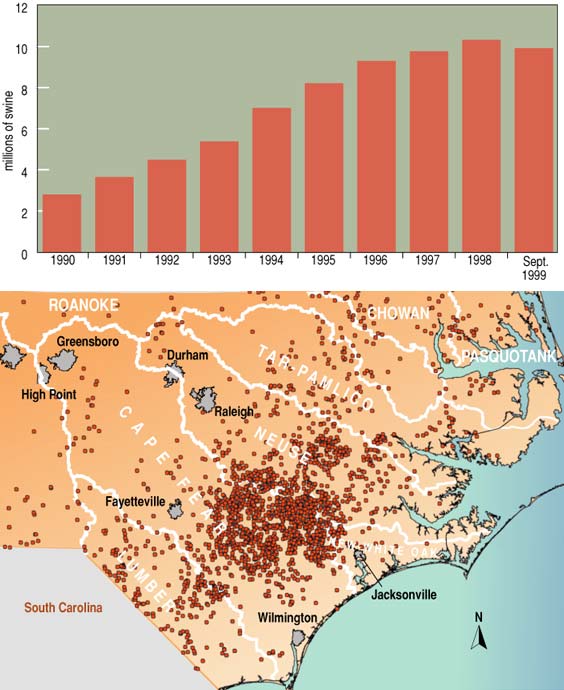
These factory-style concentrated animal operations, or CAOs, are based on models used extensively for poultry in Arkansas and eastern states such as Maryland, Delaware and Virginia, particularly in the region known as the Delmarva Peninsula. The industrialization of the poultry industry began in the 1950s; industrial hog farming is a somewhat newer development. Concentrated operations began replacing family-style hog farms in the Midwest during the 1970s and early 1980s and achieved popularity among pork producers in North Carolina in the late 1980s. Sympathetic legislators ushered bills through the N.C. General Assembly that largely exempted such operations from local zoning ordinances, mandatory inspections and nuisance lawsuits and gave the industry a series of tax breaks as well. (This story is told by former Senator Robert Morgan in the 1998 book Pigs, Profits, and Rural Communities.)

Linda Huff
The favorable regulatory climate and availability of an inexpensive waste-disposal system led to a phenomenal rise in the North Carolina swine population, from 2.7 million head in 1990 to more than 10 million head in 1998. (According to the N.C. Department of Agriculture, the number stood at 9.9 million when Hurricane Floyd struck.) North Carolina is now, behind Iowa, the second largest state in hog production. Most of the North Carolina CAOs are located in the lower Cape Fear and Neuse river watersheds. From the scientific standpoint this proliferation of concentrated operations has transformed the state's coastal plain into a laboratory for examining the impact of industrial-scale animal production, and its waste outputs, on river and estuarine systems. In this article I present the results of our waste-spill investigations and discuss the vulnerability of the waste-disposal systems now associated with hog production to both normal rainfall and major weather events. Our research has sought to explore the pathways by which nutrient-enriched wastes reach water bodies and to determine how these nutrient loads affect the water quality of coastal streams.
When there is insufficient dissolved oxygen in a stream, fish and other aquatic organisms can die. A healthy stream, according to North Carolina water-quality standards, has a dissolved-oxygen level of 5.0 mg/L (milligrams per liter, equivalent to parts per million). The 1995 waste-lagoon spill in the New River caused river dissolved oxygen to drop to levels less than 1.0 mg/L. The fish kill extended along more than 20 miles of river (Burkholder et al. 1997). The spill also caused high levels of turbidity, or particulate matter in the water. Excess particulates swirling in a river can block sunlight needed for aquatic plant photosynthesis and interfere with the feeding of fish and shellfish. The North Carolina turbidity standard for water quality is 50 units for freshwater and 25 units for estuarine water. After the spill, turbidity in the New reached 92.8 units.
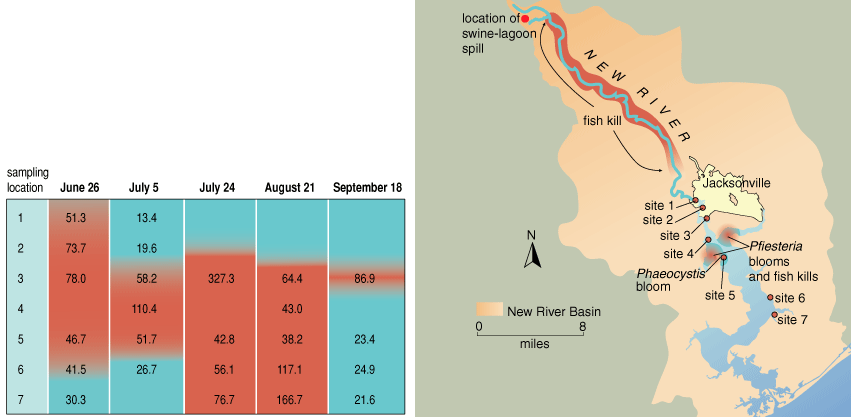

In addition, high concentrations of nitrogen and phosphorus contaminated the length of the river. What do nutrient levels of this magnitude mean to an aquatic ecosystem? Data that we have accumulated from our research in the Cape Fear watershed indicate that typical river ammonium levels range from 0.01 to 0.30 mg/L, nitrate ranges from 0.05 to 1.00 mg/L and phosphate from 0.005 to 0.150 mg/L. Ammonium levels of 40 mg/L are considered capable of causing death or injury to fish and other aquatic life through direct toxicity. Ammonium in the New River jumped to 46.21 mg/L after the spill.
However, the most common response to nutrient loading is the formation of blooms of phytoplankton (single-celled algae), some of which can be noxious or toxic to fish and invertebrates. When the hog-waste plume reached the upper New River Estuary in Jacksonville Harbor, the nutrient load caused phytoplankton blooms exceeding 300 μg/L (micrograms per liter, or parts per billion) of chlorophyll a (a measure of algal biomass). As a reference, the N.C. Division of Water Quality considers chlorophyll a concentrations exceeding 40 μg/L to indicate a nuisance algal bloom.

Several miles downstream from Jacksonville in the New River Estuary there was an algal bloom reaching 110 μg/L of chlorophyll a that was of special interest. This bloom contained high concentrations of the harmful algal species Phaeocystis globosa, which had not previously been seen in the New River Estuary. Also coinciding with this event was a bloom of the toxic dinoflagellate Pfiesteria piscicida of 1,200 cells/mL. Exhaustive field and laboratory research by JoAnn Burkholder and Howard Glasgow (1997) has established that Pfiesteria cell counts of 300/mL or greater are sufficient to kill numerous species of fish. Some 10,000 Atlantic menhaden were found dead in the estuary at the location of the Pfiesteria bloom, with many of the fish exhibiting cloacal lesions. Burkholder and her colleagues also found that the Pfiesteria populations present tested as toxic in follow-up laboratory bioassays.
The nutrients from the waste load affected the estuary for an extended period. A massive algal bloom occurred early on in the lower river and then spread downstream into the estuary. Freshwater input to the estuary is low compared with other area estuaries; thus the tides and the poorly flushed hydrology of the estuary caused the bloom to be retained until late August. Along with the blooms, dissolved-oxygen levels in the bottom waters of the lower river and upper estuary dropped below 1.0 mg/L, creating an unhealthy habitat for bottom-dwelling fish and invertebrates.
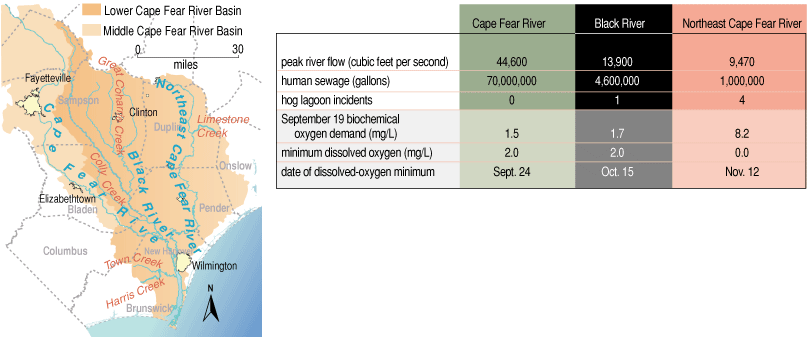
Linda Huff; Data from U.S. Geological Survey, N.C. Division of Water Quality and Michael A. Mallin.
With colleagues from my own institution and NCSU, I conducted a detailed assessment of the effects of poultry-waste lagoon accident a few weeks later (Mallin et al. 1997). This spill caused very low dissolved-oxygen levels (0.3 mg/L) and a fish kill in Limestone Creek before its plume entered the Northeast Cape Fear River. State water-quality biologists had previously rated the condition of the Limestone Creek streambed invertebrate community as "excellent." A reassessment after the spill led them to reclassify the community as "poor." A key indicator of water quality is biochemical oxygen demand, or the oxygen consumed by microorganisms decaying organic material in water. The oxygen demand from the waste load that entered the river caused a sag in the dissolved-oxygen level, which reached a minimum 10 days later 90 kilometers downstream near the town of Castle Hayne. This minimum represented the lowest dissolved-oxygen levels in 23 years of records at the Castle Hayne sampling site. Again the effects of the spill proved persistent. Unusually high levels of nutrients were found at this distant downstream site during the month following the spill.
As with the other recorded spills, the Brunswick County swine-lagoon accident introduced high turbidity and led to low dissolved-oxygen levels (0.1 mg/L) in Harris Creek. This incident also caused algal blooms, with chlorophyll a exceeding 100 μg/L in Harris Creek, which then spread throughout the associated tidal-creek network. The low dissolved oxygen and surface algal blooms in the creek system remained for about three weeks, until a substantial rainfall led to improved water quality.
Another important component of swine and poultry waste is the concentrated microbial mass excreted by the animals. Although much of this microbial flora is benign, some of the microbes are disease-causing.Vincent R. Hill and Mark D. Sobsey of the University of North Carolina at Chapel Hill (1998) have noted that many of the pathogenic microbes (bacteria, protozoa and viruses) in swine and poultry waste are able to infect people. Therefore, animal-waste spills present a direct health threat to humans contacting affected waters.
Fecal coliform bacteria are commonly used as indicators of the presence of pathogens in waters affected by polluted inputs. The N.C. Division of Water Quality uses 200 colony-forming units per 100 milliliters (200 CFU/100mL) as the state standard for safe human contact with water bodies. The spill incidents caused very high fecal coliform counts in the receiving streams-including a remarkable 3.4-million-units measurement in the New following the June swine-waste spill.
Fecal coliform counts in the stream water decreased considerably after a few days in each case. However, much of the bacterial load in the New River spill settled to the sediments, where Burkholder and her colleagues (1997) recorded fecal coliform counts exceeding 5,000 CFU/100 mL of sediment slurry for up to 61 days after the spill. The high sediment counts mean that natural or human disturbance of these contaminated sediments could resuspend potentially dangerous amounts of bacteria and other microbes back into the water column for weeks after a spill event. Thus, water that appears to be safe based on water-column fecal-coliform counts may still represent a human health danger.
Under dry to average conditions, animal waste from livestock and poultry operations enters rivers through accidental waste spills and runoff from sprayfields. In the Southeast, frequented by hurricanes, the vulnerability of these waste-handling systems to severe storms is a special concern.
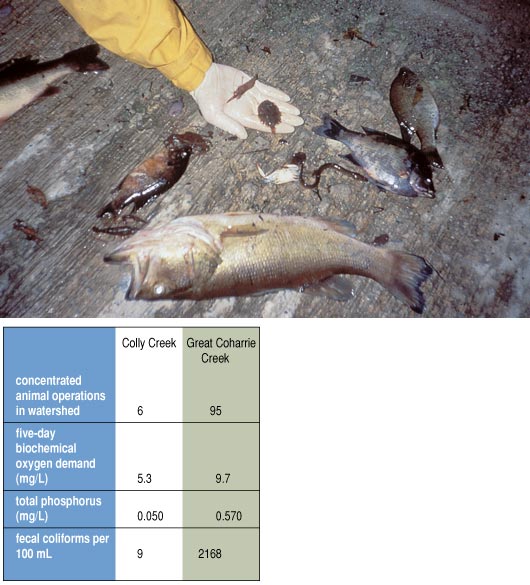
Linda Huff; Photograph courtesy of Michael A. Mallin.
State records show that in 1996, the extreme rainfall associated with the September passage of Hurricane Fran led to ruptures, excessive overflows and floodplain inundations at some 22 animal-waste lagoons in North Carolina. At least four swine-waste lagoons ruptured or were inundated along the Northeast Cape Fear River, contributing to extended near-anoxic periods and fish and invertebrate kills. Meanwhile power failures led to the rerouting of untreated human sewage into the three main branches of the Cape Fear River. But the impact of the swine-waste lagoon overflows appears to have been much more potent and long-lasting.
My laboratory collaborated with Martin Posey's Benthic Ecology Laboratory at UNC-Wilmington to assess the effects of Hurricane Fran on water quality and benthic organisms in the Cape Fear system (1999). We found that all of the main tributaries were affected by Fran, but the most severe and persistent water-quality effects occurred in the Northeast Cape Fear River, where the amount of human sewage spilled was smaller but where impacts from swine lagoons were coincidentally the greatest.
In August 1998 Hurricane Bonnie struck the Cape Fear region. Extensive rains were also associated with this event. There was only one major swine-lagoon incident reported, possibly a result of improvements in operations in response to increased lagoon inspections by state regulators during the previous two years. However, the siting of waste lagoons on river floodplains remained a major environmental problem in the region. Several days after Bonnie's passage our field biologists observed CAO operators spraying large quantities of waste onto sprayfields already saturated by rain from the hurricane and subsequent rainfall. This may have been done to prevent the waste lagoons in that area from overtopping in response to the high rainfall. Such spraying, also observed after Hurricane Floyd, is a legal practice but environmentally unsound, since saturated sprayfields cannot absorb the waste.
We collected water samples for five-day measurements of biochemical oxygen demand in the river just downstream of the spray activity. The normal five-day total oxygen demand in this river is 1.0 mg/L. The samples downstream from the spraying yielded five-day oxygen-consumption totals of 9.0 mg/L, compared with 4.0 mg/L downstream from municipal sewage bypasses. Dissolved oxygen in the lower Northeast Cape Fear River stayed at near anoxic levels for almost two weeks. The fish kill associated with these conditions was massive (more than 10,000 fish); affected were numerous fish species including largemouth bass, catfish, chain pickerel, hogchokers and various sunfish, as well as invertebrates including blue crabs, shrimp and crayfish. Dissolved oxygen in that area of the river did not recover to a "healthy" level of 5.0 mg/L for two months. Spraying large amounts of waste onto saturated fields thus appears to pollute downstream waters in ways similar to lagoon spills or overtoppings.
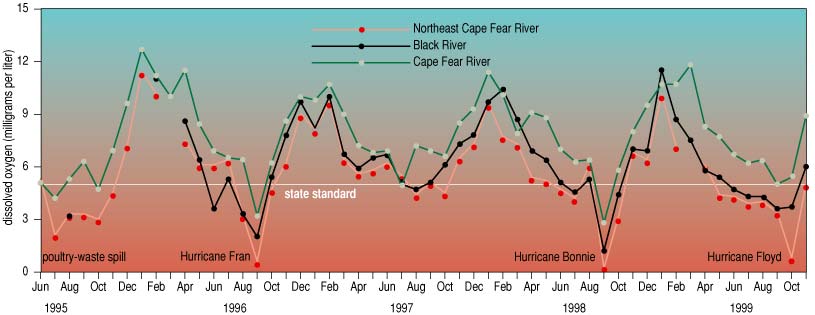
Linda Huff
In the language of water quality, discharges from sewage-treatment plants or animal-waste lagoons are measurable "point sources" of pollution. Runoff of agricultural chemicals and nutrients from the land, by contrast, is difficult to measure. To investigate the effect in a storm of runoff from animal-waste sprayfields, we compared drainage from a relatively pristine stream basin (Colly Creek) with that of a basin rich in concentrated animal operations (Great Coharrie Creek) five days after Hurricane Bonnie. Drainage water in Great Coharrie Creek had twice the biochemical oxygen demand, 10 times the total phosphorus and fecal coliform bacterial counts 250 times higher than that of Colly Creek, a situation caused by runoff initiated by the heavy rainfall. Thus, even in the absence of major lagoon accidents, the siting of swine facilities and sprayfields on river floodplains can be environmentally hazardous.
An examination of monthly dissolved-oxygen levels in the three main branches of the Cape Fear system shows how waste from concentrated animal operations influences river water quality under these conditions. Dramatic drops in dissolved oxygen in the Cape Fear system can be clearly associated with the events I have described: the poultry-waste lagoon rupture (July 1995), hurricanes in 1996, 1998 and 1999, with the associated swine-lagoon accidents, waste spraying onto rain-saturated floodplain fields and municipal waste overflows, and discharging of swamp water into rivers.
The spectacular consequences of flooding in areas dominated by concentrated animal operations are one thing; the effect of chronic pollutant loading is another. The quantities of waste generated by these operations are enormous, and disposal is a continuing challenge.
Liquid waste or poultry litter is continually deposited on fields adjoining these operations after storage in the lagoon. Like all manures, these are highly concentrated sources of nutrients such as phosphorus and nitrogen. Normal rainfall events carry a portion of this nutrient load either overland across the field or through the shallow groundwater into nearby receiving streams. Typically, when nutrient concentrations are measured in runoff and streams around these operations, the readings are high enough to cause damage to aquatic ecosystems. Sewage-treatment plants and row-crop agriculture can be other significant sources of stream nutrients.
The effects of nutrient loading are sometimes manifested as algal blooms in receiving waters. During summer low-flow periods, our routine monitoring of streams in the Cape Fear River basin occasionally detects algal blooms in streams draining areas rich in animal operations and in streams downstream of point-source discharges. However, in coastal-plain streams the effect of nutrient loading on ambient dissolved oxygen may be an even more crucial problem.
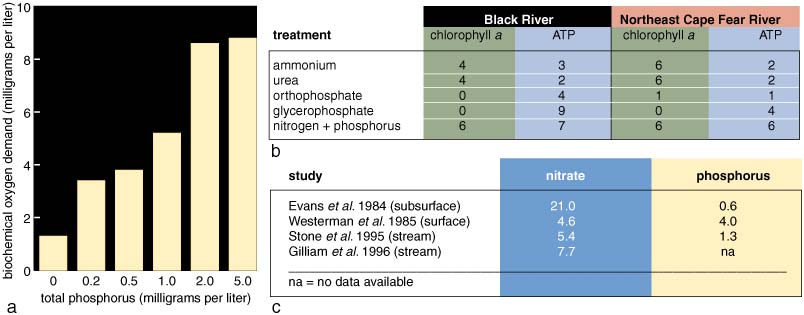
The surface-water systems in the major swine-production areas in coastal North Carolina are composed primarily of blackwater streams. These waters are darkly stained by leachate from streamside vegetation but are normally low in turbidity. The streams are sluggish, characterized by gentle gradients, and have naturally low dissolved oxygen (4.0-6.0 mg/L) during summer, making them unusually sensitive to increases in biochemical oxygen demand.
To understand how these waters respond to nutrient loading, we began conducting experiments to determine what effect inputs of nitrogen and phosphorus at levels typical of those in receiving streams would have on stream water quality. We collected water from blackwater rivers in swine-producing areas, distributed the water into 4-liter floatable plastic containers and added various nutrient treatments to the containers. We used ammonium as an inorganic nitrogen treatment, urea as an organic nitrogen treatment, orthophosphate as an inorganic phosphorus treatment, glycerophosphate as an organic phosphorus treatment, a combined ammonium plus orthophosphate treatment and a control of no nutrient inputs. The concentrations of nitrogen or phosphorus were 1.0 mg/L for each nutrient treatment.
The containers were incubated for six days outdoors in screen-covered pools and kept in motion by aquarium pumps. Periodically the containers were sampled to assess production of chlorophyll a and ATP, relative to control samples with no nutrient additions. Chlorophyll a is a measure of algal biomass, whereas ATP is a general measure of the biomass increase for all organisms in a sample.
In experiments conducted on water from the Black and Northeast Cape Fear Rivers, nitrogen additions mainly stimulated chlorophyll a concentrations (autotrophic organisms) whereas phosphorus additions only stimulated ATP production. When only ATP and not chlorophyll a is stimulated, it is likely that the heterotrophic community (bacteria, fungi and protozoans, rather than algae) is responsible for the ATP increase. Increases in heterotrophs directly increase the biochemical oxygen demand and lead to lower dissolved oxygen.
During subsequent experiments we demonstrated that nitrogen and phosphorus concentrations similar to those in Figure 10 can cause significant increases in oxygen demand in blackwater streams. Phytoplankton that bloom in shallow streams typically die and decompose upon entering deep, light-limited blackwater coastal-plain rivers, becoming yet another source of biochemical oxygen demand. These processes take place primarily during late spring and summer, when the water, being warm, holds less dissolved oxygen than it does during cooler seasons. The clustering of concentrated animal operations in certain geographic regions, particularly in basins of slow-flowing blackwater streams, puts these water bodies particularly at risk.
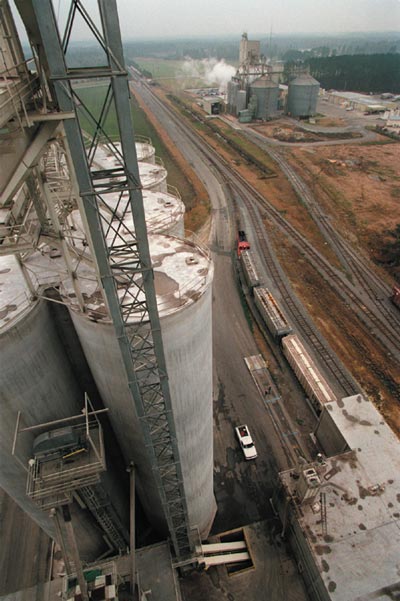
Robert Willett, The News and Observer
Animal-waste lagoons also have been shown to leak nutrients into nearby soils and groundwater. Groundwater may then enter streams or well water used for human consumption. A study of 11 unlined North Carolina swine-waste lagoons by Rodney L. Huffman and Philip Westerman of North Carolina State University in 1995 found that 55 percent demonstrated moderate to severe seepage losses of nitrogen. Average ammonia-nitrogen concentrations up to 1,000 mg/L and nitrate-nitrogen up to 50 mg/L were found in some wells near a clay-lined swine-waste lagoon on the Delmarva Peninsula (Ritter and Chinside 1990).
In a 1995 study in North Carolina, Westerman and his NCSU colleagues found ammonia-N concentrations up to 300 mg/L and nitrate-N up to 40 mg/L in wells downslope of unlined swine waste lagoons. Wells upslope of lagoons had ammonia-N concentrations of 0.2 mg/L or less and nitrate-N of 3.3 mg/L or less. Some of the studies concluded that higher seepage took place near lagoons on excessively well-drained soils, with less seepage from lagoons in poorly drained soils.
Thus, depending on local soil characteristics, some of this leakage can eventually find its way to surface water bodies through lateral transport by shallow groundwater. There is also a direct human health aspect to high nitrogen levels in groundwater. The U.S. Environmental Protection Agency's drinking-water standard for well water is 10 mg/L of nitrate or less, a limit designed to prevent an infant blood disorder known as "blue baby syndrome," or methemoglobinemia. In the body nitrate is reduced to nitrite, which converts hemoglobin to methemoglobin, making red blood cells unable to carry oxygen.
As a question of public policy, the growth of concentrated animal operations must be considered against the carrying capacity of the environments in which these operations are placed. Lawrence B. Cahoon, Jill A. Mickucki and I found (1999) that the amount of nitrogen and phosphorus in animal feed required to feed the 1995 swine, poultry and cattle population in the Cape Fear watershed came to approximately 100,000 tons of nitrogen and 33,000 tons of phosphorus. Over 90 percent of this input came into the watershed from other regions as far away as the Midwest, where feed is produced. More recently, Howard Glasgow and JoAnn Burkholder (in press) estimated that in 1998 animal operations in the nearby Neuse River basin required approximately 54,000 tons of nitrogen and 17,800 tons of phosphorus in feeds, of which 69 percent and 88 percent, respectively, were imported into the basin from elsewhere. These are staggeringly large quantities of "new" nutrients, of which about 75 percent remains in the watershed as animal waste in lagoons or on litterfields and sprayfields.
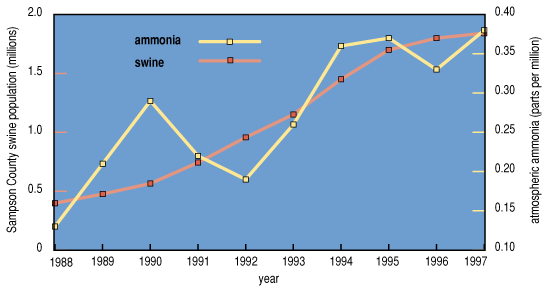
Linda Huff
Of course nitrogen and phosphorus are traditionally taken up by crop plants, so some part of this input is potentially useful in the region's agriculture. It turns out to be a small part. The industrialization of swine production in North Carolina has been comparatively recent, but James C. Barker and Joseph P. Zublena of NCSU (1995) found that by 1993 three counties in North Carolina already generated more nitrogen and 18 counties more phosphorus in animal manure than could be utilized for the entire local crop production.
The 1997 Blue Ribbon Citizens Pfiesteria Action Commission report to the Governor of Maryland indicated that by 1991 the largest poultry-producing region in the state, the Southern Eastern Shore, was applying more phosphorus in manure to the crop fields than the crops could utilize. Soils in a number of areas rich in concentrated animal operations are accumulating excessive amounts of phosphorus. Phosphate is normally bound to soil particles and thus sequestered; however, when binding sites become saturated, excess phosphorus than may enter groundwater or nearby surface water bodies. This is particularly true when soils are sandy (as is typical in coastal plains) and well-drained or highly organic (Williams, Barker and Sims 1999). Over time, continual loading of animal wastes as liquid or litter saturates fields with nutrients, exacerbating eutrophication problems in surface-water supplies.
Industrial animal production facilities can also contribute nutrients to nearby waterways through atmospheric nitrogen deposition. Large amounts of the nitrogen applied to sprayfields is volatilized as ammonia, which becomes airborne and is deposited elsewhere. An example of an ammonia-producing area is Sampson County, North Carolina, an area of 946 square miles that with 1.8 million head was one of the nation's top swine-producing counties in 1998. The National Atmospheric Deposition Program (NADP) has monitored atmospheric ammonia at a Sampson County site since 1978. During the past 10 years there has been a concurrent rise in atmospheric ammonia and the swine population. Linear-regression analysis indicates that 72 percent of the variability in airborne ammonia can be explained by changes in the county swine population alone. Upwind in the North Carolina Piedmont, NADP sites in counties with low swine populations (Rowan and Wake) showed no ammonia increase over that same period.
Major pollution events caused by concentrated animal operations are by no means limited to one state or region. For example, in 1995 the Missouri Department of Natural Resources levied fines against pork producers for waste spills that caused the deaths of hundreds of thousands of fish in nearby waterways. The U.S. EPA and the Justice Department fined an Iowa producer for an illegal 1997 hog-waste discharge that killed more than 100,000 fish in a creek. Other hog-waste spills and consequent fish kills have occurred in Iowa as well (see Thu and Durrenberger 1998), and an August 1999 series of articles in The Washington Post documented substantial poultry-waste spills into waterways in Virginia and Delaware.
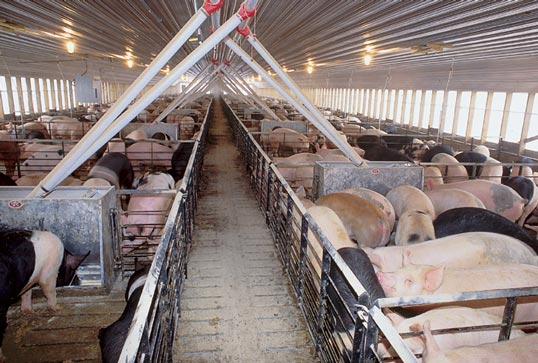
Larry Lefever from Grant Heilman
What is the prognosis for surface water resources in major swine- and poultry-producing areas? In 1993 the N.C. General Assembly promulgated regulations that mandated waste-management plans and clay liners for new waste lagoons. As a result of the 1995 and 1996 animal-waste incidents, in 1997 the General Assembly placed a two-year moratorium on new construction of concentrated animal operations; this moratorium was recently extended for another year. This legislative action also banned future building of hog houses and waste lagoons on the 100-year floodplain. However, new sprayfields were still permitted to be constructed and operated on the floodplain. Recently, the U.S. EPA has begun to address the problem. In a North Carolina case currently in litigation, EPA is arguing that livestock facilities that have discharged waste, including discharges from sprayfields, are required to apply for and obtain a National Pollution Discharge Elimination System (NPDES) permit.
Various management and technological strategies to reduce or better utilize the large amounts of waste generated by CAOs are currently being investigated at various locations such as N.C. State University's Animal and Poultry Waste Management Center. (For a review see Williams, Barker and Sims 1999.) One promising technique is enzyme (phytase) supplements in animal feeds to enhance digestion of phosphorus. This technique can result in significant decreases in the amount of phosphorus excreted by livestock. However, even with widespread use of this technology there still remain vast quantities of waste phosphorus to deal with, as well as much larger quantities of nitrogen. Per capita meat consumption in the developed world is not expected to grow over the next two decades; however, demand for pork and other meats is rapidly increasing and is expected to continue to grow in the Third World. With the expansion of industrial livestock production to areas such as the American West and South America, it is imperative that local communities anticipate potential environmental problems and design waste management and enforcement systems accordingly.
Funding for these research efforts was provided by the Lower Cape Fear River Program, the Water Resources Research Institute of the University of North Carolina (Project #s 70156 and 70171), and the Z. Smith Reynolds Foundation. Helpful manuscript criticism was provided by JoAnn M. Burkholder and Lawrence B. Cahoon. For field and laboratory assistance the author thanks David S. Briley, Nora Deamer-Melia, Scott H. Ensign, Howard B. Glasgow, Jr., Elle K. Hannon, Matthew R. McIver, Douglas C. Parsons, G. Christopher Shank, Ashley R. Skeen, Jeffrey R. Springer, Brant W. Touchette and Tracey L. Wheeler. The WIlmington and Raleigh offices of the N.C. Division of Water Quality provided much helpful information.
Click "American Scientist" to access home page
American Scientist Comments and Discussion
To discuss our articles or comment on them, please share them and tag American Scientist on social media platforms. Here are links to our profiles on Twitter, Facebook, and LinkedIn.
If we re-share your post, we will moderate comments/discussion following our comments policy.